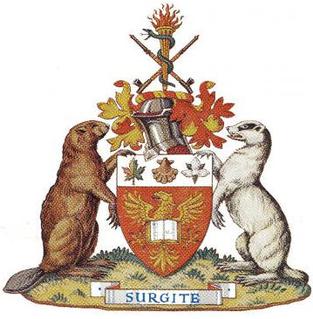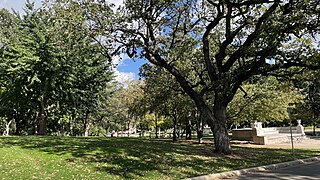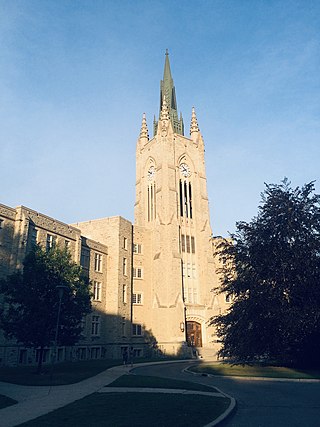
The University of Missouri–Kansas City is a public research university in Kansas City, Missouri. UMKC is part of the University of Missouri System and has a medical school. For the 2023-2024 academic year, the university's enrollment was over 15,300 students. It is the largest university and third largest college in the Kansas City metropolitan area. It offers more than 125 degree programs over 11 academic units. It is classified among "R2: Doctoral Universities – High research activity".

De Montfort University Leicester (DMU) is a public university in the city of Leicester, England. It was established in accordance with the Further and Higher Education Act in 1992 as a degree awarding body. The name De Montfort University was taken from Simon de Montfort, a 13th-century Earl of Leicester.

The University of Ontario Institute of Technology, branded as Ontario Tech University or Ontario Tech, is a public research university located in Oshawa, Ontario, Canada. The university's main campus is located on approximately 160 hectares of land in northern Oshawa, while its secondary satellite campus is situated in downtown Oshawa. The university is a co-educational institution that operates seven academic faculties.

The University of Windsor is a public research university in Windsor, Ontario, Canada. It is Canada's southernmost university. It has approximately 17,500 students. The university was incorporated by the provincial government in 1962 and has more than 150,000 alumni.

Brock University is a public research university in St. Catharines, Ontario, Canada. It is the only university in Canada in a UNESCO Biosphere Reserve, at the centre of Canada's Niagara Peninsula on the Niagara Escarpment. The university bears the name of Maj.-General Sir Isaac Brock, who was responsible for defending Upper Canada against the United States during the War of 1812.

Ivey Business School is the main business school of the University of Western Ontario, located in London, Ontario, Canada. It offers full-time undergraduate and graduate programs and maintains two teaching facilities in Toronto and Hong Kong for its EMBA and Executive Education programs.

The Bauhaus-Universität Weimar is a university located in Weimar, Germany, and specializes in the artistic and technical fields. Established in 1860 as the Great Ducal Saxon Art School, it gained collegiate status on 3 June 1910. In 1919 the school was renamed Bauhaus by its new director Walter Gropius and it received its present name in 1996. There are more than 4000 students enrolled, with the percentage of international students above the national average at around 27%. In 2010 the Bauhaus-Universität Weimar commemorated its 150th anniversary as an art school and college in Weimar.

The Technological Institute, more commonly known as "Tech", is a landmark building at Northwestern University built from 1940 to 1942. It is the main building for students and faculty in the Robert R. McCormick School of Engineering and Applied Science. The school of engineering itself was called the Technological Institute before a major gift from the Robert R. McCormick Foundation gave it the present name.
The campus of the University of California, Berkeley, and its surrounding community are home to a number of notable buildings by early 20th-century campus architect John Galen Howard, his peer Bernard Maybeck, and their colleague Julia Morgan. Subsequent tenures as supervising architect held by George W. Kelham and Arthur Brown, Jr. saw the addition of several buildings in neoclassical and other revival styles, while the building boom after World War II introduced modernist buildings by architects such as Vernon DeMars, Joseph Esherick, John Carl Warnecke, Gardner Dailey, Anshen & Allen, and Skidmore, Owings and Merrill. Recent decades have seen additions including the postmodernist Haas School of Business by Charles Willard Moore, Soda Hall by Edward Larrabee Barnes, and the East Asian Library by Tod Williams Billie Tsien Architects.

The Macdonald Campus of McGill University houses McGill's Faculty of Agricultural and Environmental Sciences (FAES), which includes the Institute of Parasitology, the School of Human Nutrition and the McGill School of Environment. It is located in Sainte-Anne-de-Bellevue, Quebec, in the West Island region of the Island of Montreal. The property is also the home of John Abbott College.

The Faculty of Engineering is one of the constituent faculties of McGill University in Montreal, Quebec, Canada, offering undergraduate and graduate degrees in bio-engineering, bioresource, chemical, civil, computer, electrical, mechanical, materials, mining, and software engineering. The faculty also comprises the School of Architecture and the School of Urban Planning, and teaches courses in bio-resource engineering and biomedical engineering at the master's level.

The University of Minnesota Old Campus Historic District is a historic district located in Minneapolis, Minnesota. Listed in the National Register of Historic Places since 1984, it includes a number of historic buildings that were constructed during the late 1800s and early 1900s, and represents the oldest extant section of the University of Minnesota campus. The general area was designed by landscape architect Horace W. S. Cleveland, who envisioned a park-like University. His plan, that he presented to the Board of Regents, went on to help form the Historic District. It is located directly to the north of the University's Northrop Mall Historic District.

Highfield Campus is the main campus of the University of Southampton and is located in Southampton, southern England. It is the largest of the university's campuses with most of the students studying there. The campus is also the location of the main university library, the students' union as well as sports facilities.

Zijingang Campus is the main campus of Zhejiang University. Located in the west of urban Hangzhou, it borders the Yuhangtang River in the south, hence the name. With an area of 8,700 mu, it is the largest single university campus in mainland China.
The campus of Northwestern University encompasses two campuses in Evanston, Illinois and Chicago, Illinois, United States. There is an additional campus located in Doha, Qatar which offers bachelor's and master's degrees. The original Evanston campus has witnessed approximately 150 buildings rise on its 240 acres (0.97 km2) since the first building opened in 1855. The downtown Chicago campus of approximately 25 acres (100,000 m2) is home to the schools of medicine and law was purchased and constructed in the 1920s and 1930s.
The Don Wright Faculty of Music is the faculty of music at the University of Western Ontario in London, Ontario, Canada. The faculty was founded in 1968. Originally known as just the Faculty of Music, it was renamed in 2002 in honour of Don Wright after a significant donation.

The Queens Campus or Old Queens Campus is a historic section of the College Avenue Campus of Rutgers, The State University of New Jersey in New Brunswick, New Jersey, in the United States.
Western Libraries is the library system of the University of Western Ontario in London, Ontario. In 1898, the university Senate appointed James Waddell Tupper as the University of Western Ontario's first University Librarian. In 1918, John Davis Barnett founded the Western Libraries collection with a donation of 40,000 books from his personal library. Before this donation, the collection held less than 1000 different works.

Middlesex College is an academic building located on the campus of the University of Western Ontario. The building is known for its collegiate Gothic architecture, spire, and clock tower. It currently houses the Department of Mathematics and Computer Science.
















